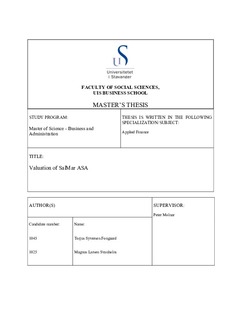| dc.description.abstract | This thesis examines the fair value per share of SalMar ASA, a Norwegian salmon farming company, at 3rd of May 2017. The analysis has been performed using fundamental and relative valuation methods. Future cash flows are forecasted using key value drivers identified and analyzed in a thorough strategic and historical performance analysis. The value per share is derived by discounting future cash flows at a weighted average cost of capital before subtracting debt and non-equity claims. At last the sensitivity of estimates is thoroughly analyzed. Firstly, the macro analysis uncovers how regulations due sustainability challenges limits further organic growth in the industry, despite favorable economic conditions for a continued demand growth for salmon. Secondly, the industry analysis uncovers a threat of increased salmon supply due to new entrants within non-traditional salmon farming methods. Thirdly, the resource based-view analysis uncovers short term competitive advantages in SalMar ASA’s optimized value chain, license locations and ocean farming technology. At last, the historical performance analysis reveal how SalMar has a history of stronger operating margin, lower operational cost, and higher return on invested capital compared to peers. The development in non-financial drivers are forecasted based on the results of the strategic and historical performance analysis. Salmon price is expected to stay strong in the short run, but revert to a lower historical average as supply from non-traditional farming methods gradually increase. Cost of goods sold is expected to decrease while fixed assets per license is expected to increase over the explicit forecast period. This is due to larger investments in cost efficient solutions including ocean farming technology, and self- sufficient smolt production. As a result, the forecast exhibits a continued high operating margin while return on invested capital declines compared to historical levels. Based on, these assumptions the fundamental valuation derives a fair value per share of NOK 153, while the relative valuation suggests a value interval of NOK 174-240. The sensitivity analysis uncovers a large value sensitivity to forecasted salmon price and cost of goods sold. The scenario analysis investigates the effect of success and failure of investments in cost improving technologies, ceteris paribus, where the result suggests a fair value per share of NOK 201 in case of success, and 90 in case of failure. At last, a Monte Carlo Simulation based on the historical probability distribution of the salmon price, suggests that the base case fair value per share estimate is less than 40% probable. The thesis concludes that the fair value per share for SalMar ASA is NOK 153 ~30% lower than today’s market price. | nb_NO |
